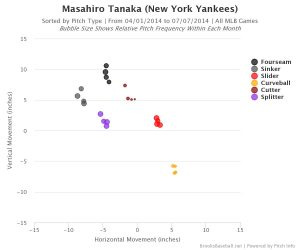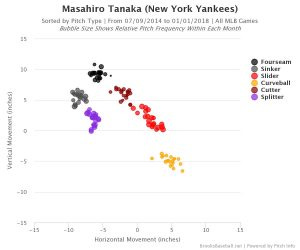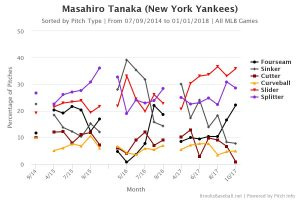Masahiro Tanaka: before and after
Baseball is America’s pastime. If there is any other place in the world where the sport is as big as it is in the United States, it's Japan. However, there are some subtle differences when it comes to the way the game is played. One of them is that the ball is slightly smaller and tackier, not needing to be rubbed up as much when new. Some believe that this has the ability to affect pitchers who make the journey from Japan to the MLB.
Of course, the most recent import for the Yankees is Masahiro Tanaka. Yes, he has had an elbow injury that might have effected his pitching style over the course of his first four seasons in the Majors. But are there any differences between how Tanaka pitched in Japan versus how he has pitched in the States?
The following analysis is derived from only having a very small sample of pitches tracked by PITCHf/x for Tanaka pre-MLB compared to a much larger set of data since he has come over. Thus, the conclusions will not be strong, but they still could give interesting insights into Tanaka’s career arc.
It might be easier to visualize this data in the form of scatter charts, comparing non-MLB to MLB games side by side.
Pitch Movement


Everything looks fairly similar except for one discrepancy: the development of his cutter. Many recent Yankees pitchers have added this pitch to their arsenal (CC Sabathia is one example) due to Core Four members Andy Pettitte and Mariano Rivera having much success with the pitch.
A surprising observation is that based on the graphs, Tanaka’s splitter actually averages a slight vertical movement while moving into right-handed hitters five to seven inches on average. The same notion arises with his slider: it appears to have an average vertical movement of two to three inches upwards. All of these ideas appear to be consistent with the small sample of non-MLB pitches that were tracked.
So while that does not lead to any groundbreaking insights, what about comparing Tanaka pre- and post-elbow injury? The injury first arose after a loss to the Cleveland Indians on July 8, 2014, during his first year in the MLB.


Again, everything looks fairly similar, except for the fact that he had slightly more break on his curveball before the injury.
Release Point
Another question regarding his elbow could be whether or not his release point changed.


Once again, Tanaka was fairly consistent as the above graphs indicate. Given that his release point practically stayed the same, it can be said that he truly did not have any hesitations throwing his pitches after his injury. Moreover, he actually has thrown a higher percentage of his pitches as splitters since the elbow initially flared up, as shown below.


What went wrong in 2017?
So why was his 2017 campaign so much worse than his others? It is hard to tell. Looking at some of his batted ball numbers, they all seem to be fairly in line with those from other years. The only one that stands out is HR/FB, which jumped all the way up to 21.2% in 2017. This means that of the flyballs he was giving up, many more were going over the wall.

However, based on his performance towards the tail-end of last season and his dominance in the postseason, I would bet that Tanaka returns more to the form he was in from 2014-2016 and consider 2017 to be more of an outlier.

